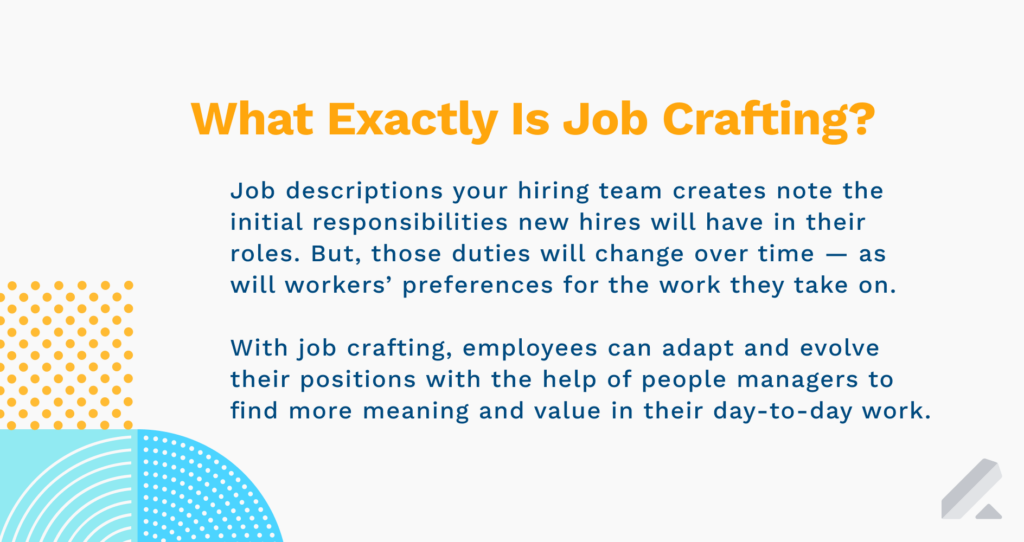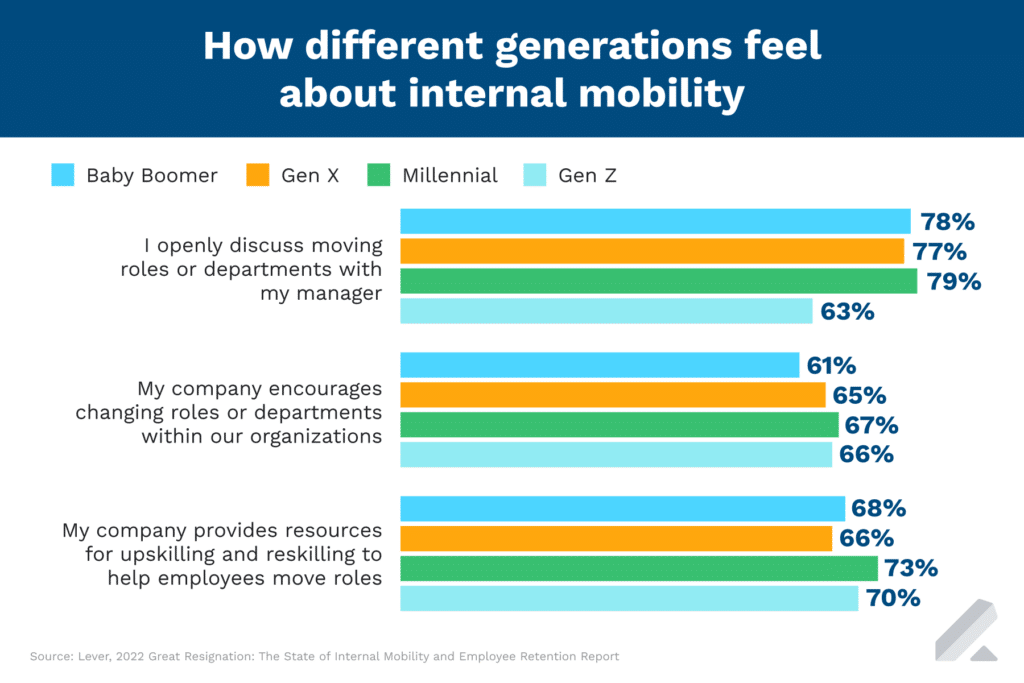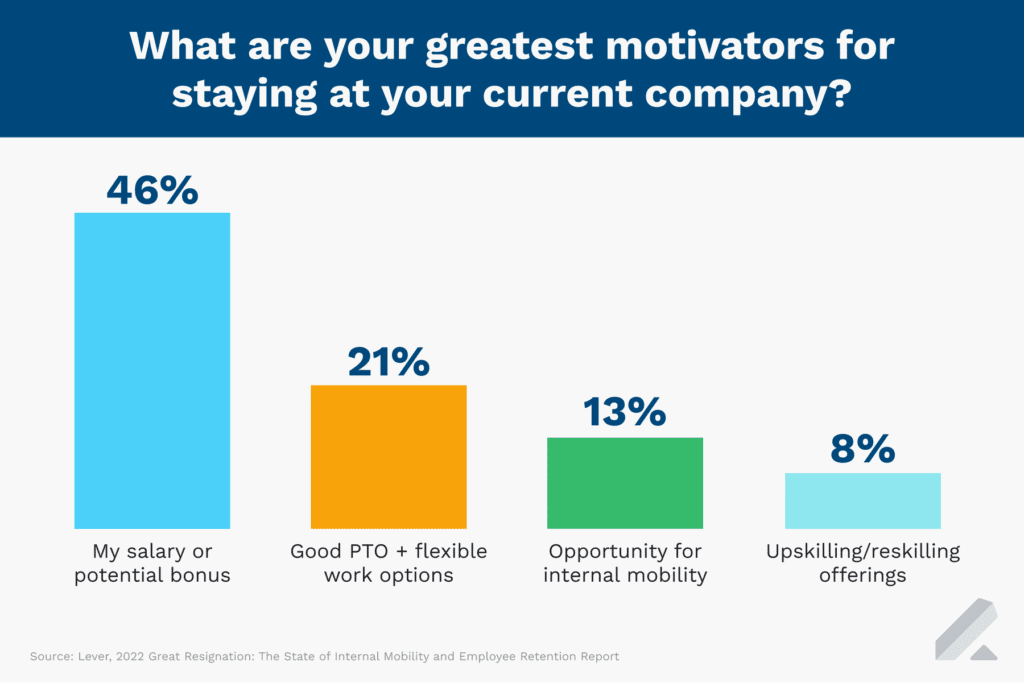Employ’s Q1 2023 Quarterly Insights Report found more than half (52%) of job seekers cited career advancement as their main motivator behind their job search.
However, there are other, similar motivating factors at play in their searches too.
Lever’s recent Internal Mobility and Employee Retention Report found two in five professionals asked their managers for some type of change to their current (at the time) role to ensure they could realize their desired career paths.
Put plainly, retention is a major focal point for mid-sized and enterprise employers today and will assuredly remain as much in the years ahead.
Layoffs and hiring freezes may have defined the labor market in 2022-23.
That being said, executives and people managers alike understand the (very important) need to retain their highest-performing employees amid the uncertainty around the economy and business climate to ensure they achieve their long-term growth goals.
And one of the best ways they can accomplish just that is through job crafting.

What is job crafting? Understanding the modern (and popular) talent management approach
Your hiring team spends a lot of time refining and optimizing job descriptions for roles across your org to ensure they account for the impact a desired hire will have on their team and business at large and explains what their initial duties and growth opportunities will be.
Sometimes, though, those initial set of responsibilities in job descriptions remain the only ones for the first several months (or even years) of an employee’s time at a given business.
This overall lack of new opportunities for an employee to develop new (and evolve existing) skill sets can (and usually does) compel them to look for new positions outside their org, since their career growth paths are stunted — or nonexistent — at their current companies.
Enter job crafting, a premier retention tool available to employers today.
NYU Assistant Professor of Management and Organizational Behavior Amy Wrzesniewski, Ph.D, and University of Michigan William Russell Kelly Business Administration Professor Jane E. Dutton, Ph.D, produced a 2001 report that proposed the concept of job-crafting exercises.
Specifically, Wrzesniewski and Dutton put forward the hypothesis that companies that engaged in job crafting allow “job crafters” (i.e., employees) to “alter work meanings and work identity” in a way that make employees feel more empowered in their respective roles.
Roles they could redefine with the aid of their people managers, per the study.

There are three distinct types of job crafting orgs can use to meet the job demands of their workforce (i.e., what they want to achieve and do in their day-to-day) and, in turn, boost their employee’s job satisfaction, per the study:
- Task crafting: This is arguably the simplest form of job crafting. It simply entails workers expressing existing tasks and projects they’d prefer not to work on anymore and propose new initiatives they’d like to undertake. If Brian in Marketing prefers to expand the scope of his role to work on the strategy behind long-term, integrated campaigns and less on the nitty-gritty work of executing said campaigns, they can work with their manager to define this new job.
- Relationship crafting: With this approach, employees are encouraged to seek out new ways of working in their current roles through “changing up” the people with whom they engage to complete their work and achieve KPIs. Take software developers. Instead of solely relying on internal stakeholders’ feedback and requests to improve their tech offering, they can seek out customers’ to learn their wants and needs as it relates to their solution to improve it.
- Cognitive crafting: How employees think about their work can alter how they go about completing day-to-day duties and, at a more macro level, their general viewpoint on the merit and value of their work. In other words, this job-crafting method is more about finding meaning in one’s existing job, not seeking to change it or move to another role, necessarily.
“Rather than paint employees as passive recipients of job tasks … our job-crafting model indicates that employees alter their jobs and use the feedback from these alterations to further motivate job crafting,” Wrzesniewski and Dutton wrote.

How job crafting can boost employee satisfaction, engagement at work, and retention
How your org goes about “infusing” a job-crafting mindset company-wide will differ from others. That said, the two big benefits of the approach are the same for all employers.
1) Workforce satisfaction and output improves due to “adaptable” job design
Proactive job-crafting efforts aimed to enable employees to help choose new types of work and/or modified ways of working can provide two key benefits to them:
- 1) Employees get to take ownership, so to speak, of their jobs, which often leads to increasingly greater satisfaction with their work and employers.
- 2) This elevated satisfaction stems workforce-related burnout for these individuals.
“Stressors that cause burnout can emerge from several kinds of mismatches, which reflect a bad fit between the job and basic human needs such as competence, belonging, and psychological safety,” psychology experts Michael Leiter and Christina Maslach wrote for HBR.
Happy employees aren’t always productive employees. (That is, job performance doesn’t always improve just because a staff member now takes more pleasure in their work.)
However, there is a clear correlation between contentment in the workplace and employee output that employers simply can’t ignore.
Addressing burnout and leading with more empathy are musts for HR teams, people managers, and business leaders. A “win-win” of implementing a job-crafting program is that it empowers employees and reduces their job stress.

2) Worker retention increases due to employees’ realizing desired career goals
Significantly less stress on the job and greater loyalty to their employers were two primary takeaways from a recent MIT Sloan School of Management job-crafting survey of business leaders and workers from across the globe.
Just as vital, though, the ability to “shift gears” with their roles made employees polled feel they had a clear pathway to achieve career objectives and move into long-preferred positions.
A bonus of improved retention is less strain and pressure on talent acquisition to backfill roles due to high (and ever-growing) employee turnover numbers.
Put another way? Your TA team members can continue as normal with their ongoing applicant evaluation and passive prospect sourcing without the added burden of knowing critical roles remain unfilled across teams.
Rather, they can move at their own leisure and continue to bolster their talent pool and pipeline with qualified candidates and keep the recruiting engine moving full steam ahead.
While HR and people managers build and refine job-crafting programs, your talent team must focus on finding future top-performers to engage. Learn how LeverTRM can help.



